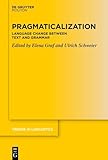Pragmaticalization : Language Change between Text and Grammar / ed. by Elena Graf, Ulrich Schweier.
Material type: TextSeries: Trends in Linguistics. Studies and Monographs [TiLSM] ; 370Publisher: Berlin ; Boston : De Gruyter Mouton, [2024]Copyright date: 2024Description: 1 online resource (VI, 402 p.)Content type:
TextSeries: Trends in Linguistics. Studies and Monographs [TiLSM] ; 370Publisher: Berlin ; Boston : De Gruyter Mouton, [2024]Copyright date: 2024Description: 1 online resource (VI, 402 p.)Content type: - 9783110760897
- 9783110761351
- 9783110761139
- 401.45
- online - DeGruyter
- Issued also in print.
| Item type | Current library | Call number | URL | Status | Notes | Barcode | |
|---|---|---|---|---|---|---|---|
 eBook
eBook
|
Biblioteca "Angelicum" Pont. Univ. S.Tommaso d'Aquino Nuvola online | online - DeGruyter (Browse shelf(Opens below)) | Online access | Not for loan (Accesso limitato) | Accesso per gli utenti autorizzati / Access for authorized users | (dgr)9783110761139 |
Frontmatter -- Contents -- Introduction -- Pragmaticalization: Language change between text and grammar – Introduction to the volume -- Part I: Pragmaticalization: Pro and contra -- 1 “Pragmaticalization” or “(inter)subjectification” of Slavic aspect – where does it apply? -- 2 The parameters of pragmaticalization -- 3 Rebalancing indexicality. Why we might not need the concept of pragmaticalization -- Part II: Pragmaticalization of discourse markers and constructions -- 4 Imperatives of visual perception verbs as discourse markers: The case of šūf in Moroccan Arabic -- 5 On the emergence and pragmatic functions of discourse markers of interruption: A case in Korean -- 6 The pragmaticalization of constructions: The Russian discourse items kak by to/tam ni bylo ‘however that may be’ and čto by to/tam ni bylo ‘whatever it is’ -- Part III: Pragmaticalization and language contact -- 7 Competing constructions and language contact: Slavic discourse-structuring elements on the basis of non-finite verba dicendi -- 8 Pragmaticalization and pragmatic borrowing in Resian -- Part IV: Pragmaticalization: Pathways of change -- 9 Imperatives as a source for the emergence of new particles in Russian -- 10 The paths of pragmaticalization: Russian pronouns of “free choice” (synchrony and diachrony) -- 11 Milestones of pragmaticalization: Russian pragmatic markers -- 12 The Russian interrogative particle razve: The pragmaticalization path -- Subject index
restricted access online access with authorization star
http://purl.org/coar/access_right/c_16ec
The present volume is dedicated to the phenomenon of pragmaticalization in the context of the theory of grammaticalization. While, in recent decades, the growing interest in the analysis of pragmatic phenomena within grammaticalization research was triggered, amongst others, by studies in the field of subjectivity and intersubjectivity in language, we still lack a model for a broad understanding of how changes on the discourse level come about and face a lack of information which provides a conclusive theoretical framework to systematically record the emergence of an entire layer of discourse units in language. The book is one of the first comprehensive collections contributed to the topic of pragmaticalization, and includes empirical studies on a wide range of languages from diachronic and synchronic perspectives. Aiming to refine our understanding of pragmatic shifts which can be observed by several linguistic units, the contributions discuss such issues as pros and cons of the concept of pragmaticalization, the parameters of pragmaticalization, the emergence of discourse markers and constructions with various pragmatic functions, pathways of change, including the influence of language contact.
Issued also in print.
Mode of access: Internet via World Wide Web.
In English.
Description based on online resource; title from PDF title page (publisher's Web site, viewed 20. Nov 2024)


